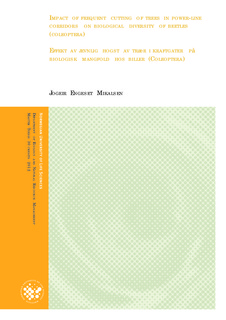Impact of frequent cutting of trees in power-line corridors on biological diversity of beetles (Coleoptera)
Abstract
Abstract
Compared to closed-canopy forest, power-line corridors are more frequently disturbed
through regular cutting of all trees. The habitat is thus maintained in an early successional
stage, with much sun exposed ground. This habitat resembles clear cuts created by modern
forestry practices, but differs from clear cuts in that it is maintained in an early successional
stage over time (i.e. not allowed to develop into later development classes). After clearing of
the corridor the biomass is not removed from the habitat and this may lead to an accumulation
of dead wood in the power-line corridors. In this study I investigated how regular disturbance
of boreal forest habitats, in the form of maintenance cutting of trees in power-line corridors,
influenced biological diversity of beetles (Coleoptera). More specific, I wanted to study if; 1)
species composition differed between power-line corridors and closed canopy forests; 2)
functional diversity differed between power-line corridors and forest, i.e. if the relative
proportion of beetles and species within functional groups, differed between the two habitats;
3) species richness and/or biodiversity was higher in power-line corridors compared to forest;
4) amount of dead wood increases species richness and/or biodiversity in the power-line
corridor and the forest and 5) distribution of rare versus common species, (species abundance
distribution) differed between power-line corridors and forests. In total 14215 beetles were
trapped with 160 interception traps from 20 sites in power-line corridors and forests during
the summer season 2010 and 2011 in the Oslo fjord region of Norway. Species composition
differed significantly between power-line corridors and forests. A total of 19 red-listed species
were trapped and eight of these were threatened. The relative proportion of individuals and
species within different functional groups also differed between the two habitats, with a
relative higher proportion of dead wood feeders in power-line corridors. Species richness and
biodiversity were significantly higher in the power-line corridor. I found a positive
relationship between both species richness and biodiversity and the amount of dead wood in
the habitats. This relationship was relatively stronger in power-line corridors. The species
abundance distribution did not differ significant between the two habitats. Power-line
corridors may help maintaining higher local biological diversity in otherwise managed forest
stands and it functions as supplementary habitat for some threatened species.
